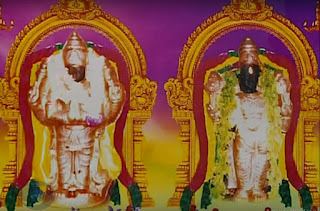GITA 11.46
 |
| SRI KAMAKSHIAMMAN TEMPLE KANCHIPURAM |
In the last sloka [46] Arjuna requested the Lord to grace Him with His image with the usual Four arms. Now, the Lord is going to hide His Viswaroopam. We may have a question, as to why the Lord does not show like this to us? Reply is, did we request the Lord? If we had requested, the Lord would never refuse to reveal Himself. If one says that one had requested, then that request might not have been sincere and true. If our prayer is sincere and with devotion, the Lord would never hide. If we carefully study Alwars' pasurams, we could notice that they had named Him as Kalvan [Thief or Cheat கள்வன்]. Are they calling Him so because He stole butter or the hearts of the girls or the minds of devotees? Our ancestors in their commentaries have mentioned that the Lord has a cheating character. Other things like stealing butter are not the ones; because butter,etc., are His. Only when we take other's property, we are said to steal. Taking one's own possession is not stealing. If the Lord hides His image, desired to be seen by His devotees, then it is cheating [kallathanam கள்ளத்தனம்]. Alwars pray the Lord not to cheat them like this. We have come to the Kshetram, Tirukalvanur [திருக் கள்வனூர்], to worship the Lord with that quality of 'deceit'. It is a small sannidhi in Sri Kamakshi Amman temple in Kanchipuram. Here the Lord is called Sri Kalvan [ஸ்ரீ கள்வன்]. Tirumangai Alwar has praised the Lord here, in one pasuram in Tirunedunthandakam. It is the same pasuram [8], we had seen earlier starting with neeragatthai [நீரகத்தாய்...], in which he mentions the name 'kalva!' [கள்வா!]. The Lord's Utsavams [festivals], qualities, Divine names, ornaments and weapons are all for the enjoyment of the devotees. If devotees could not see and enjoy them, what is the use of them? The Lord graces so many utsavams, like Pavitrotsavam, Brahmotsavam, Adyayanotsavam, Vasantotsavam, etc. Does the Lord's Eminence going to increase by these? His Eminence continues to be great from where He is. Why prasadam offerings for the Lord? Is He going to open His mouth and eat? What we desire and when we desire, we prepare and we just show to His image. And, then we eat and enjoy! So, prasadam or flower or dress, are all graced by the Lord for our enjoyment. His qualities are also for our sake. He has mercy to show it to us. His patience is to bear our misdeeds. His simplicity is to mingle with us. if He does not reveal these, then Alwars accuse Him as Kalvan or Cheat! We enter the temple crossing the large door. We can worship the Lord in a small sannidhi.
SRI KALVAN IN PICTURE FORM
In earlier days the Lord was called Sri Adivaraha Perumal [ஸ்ரீ ஆதி வராஹ பெருமாள்]. Sri Thayar is Sri Anjalaivalli Nacchiyar [ஸ்ரீ அஞ்சலைவல்லி நாச்சியார்]. Pushkarini is Nitya pushkarini [நித்ய புஷ்கரிணி ]. Vimanam is Vamana vimanam [வாமன விமானம் ]. The Lord appeared for Asvatta Narayana. Swami Periyavacchan Pillai says that the Lord is Sri Kalvan, because He is hiding in an obscure place and not revealing to the pleasure of all! Pujas are performed to the Lord. The Right lower arm is in Abhaya mudra, while the Left arm is on His Left lap, indicating that He would rescue us by reducing the samsara ocean to knee deep level. At present neither the Vamana vimanam nor the Nitya pushkarini is available for viewing, but the Lord and Sri Thayar are gracing.
 |
| SRI THAYAR AND SRI PERUMAL IN TIRUKALVANOOR |
Sri Thayar is with folded hands. Though Sri Thayar is imageless, the kumkum [குங்குமம்] distributed here is presumed to be obtained from Sri Thayar. We should worship the Lord without deceit. Should we worship Him or not? Is there God or not? Who is sustaining all of us? Going with such doubts is the deceit we possess. Going secretly and alone to worship also is another deceit. We have to worship the Lord with everybody. His deceit is not revealing Himself to His devotees. Swami Pillai Perumal Iyengar has composed a pasuram on this Kshetram in his 'Nootrettu Tirupati Andhadi [நூற்றெட்டு திருப்பதி அந்தாதி]'. He says that though our soul is a servant to the Lord from long ago, yet we assumed that the soul was ours and that we were independent not a servant to anyone. That is, we considered His property - soul - as ours. So, who is kalva [thief]? Are we not the kalvas? asks the author. But unfortunately, the Lord is called Sri Kalva, pities Swami Pillai Perumal Iyengar. But the Lord in Chapter 11 has no such deceit and He agreed to show His Viswaroopam at the request of Arjuna. We are to see sloka 47, from which the Lord speaks. Till sloka 46 Arjuna described what he saw, how he respected and was delighted and finally requested the Lord to reduce His image to the usual one. For that the Lord replies in the next Three slokas starting from sloka 47:
sri-bhagavan uvaca
maya prasannena tavarjunedam
rupam param darshitam atma-yogat
tejo-mayam vishvam anantam adyam
yan me tvad anyena na drsta-purvam
maya prasannena tavarjunedam
rupam param darshitam atma-yogat
tejo-mayam vishvam anantam adyam
yan me tvad anyena na drsta-purvam
"The Supreme Personality of Godhead said: My dear Arjuna, happily have I shown you, by My internal potency, this supreme universal form within the material world. No one before you has ever seen this primal form, unlimited and full of glaring effulgence."
(continued)

No comments:
Post a Comment